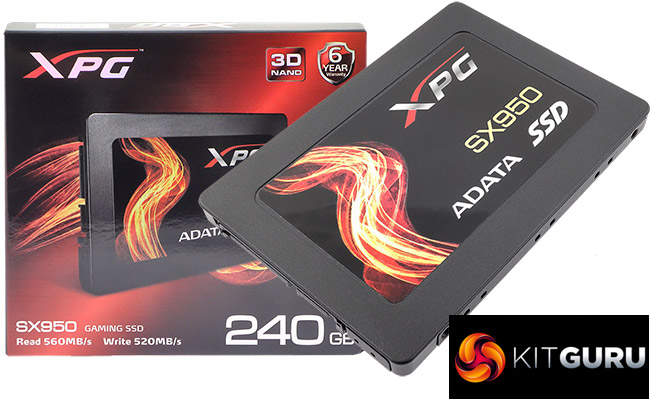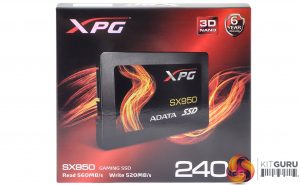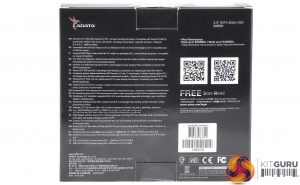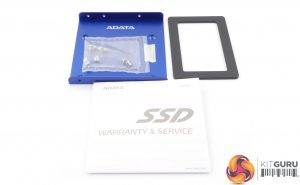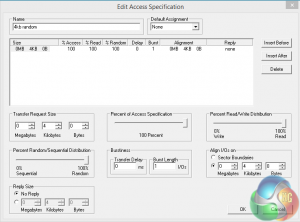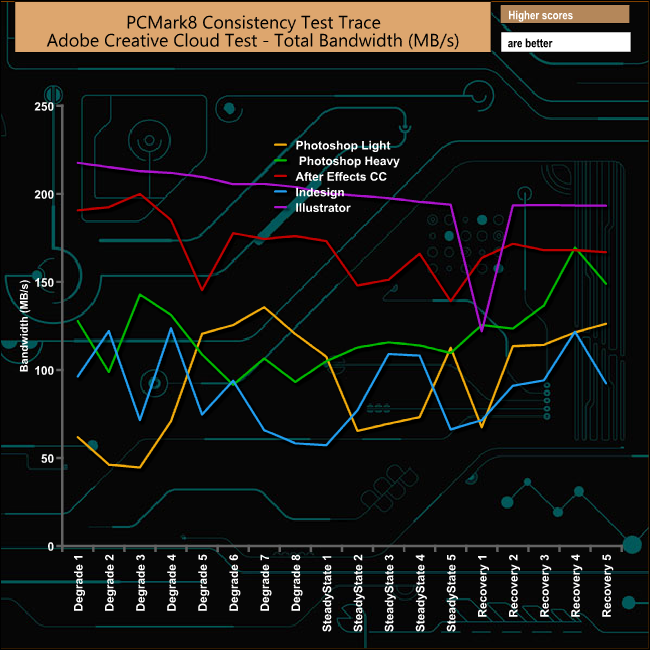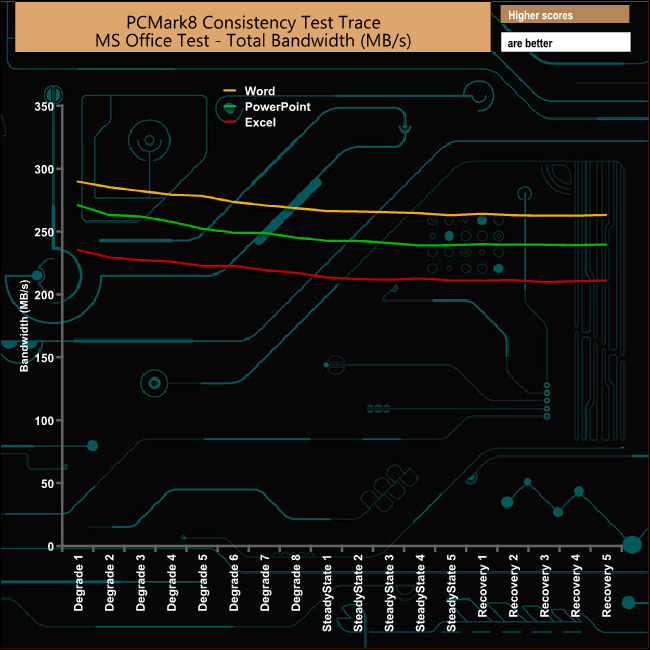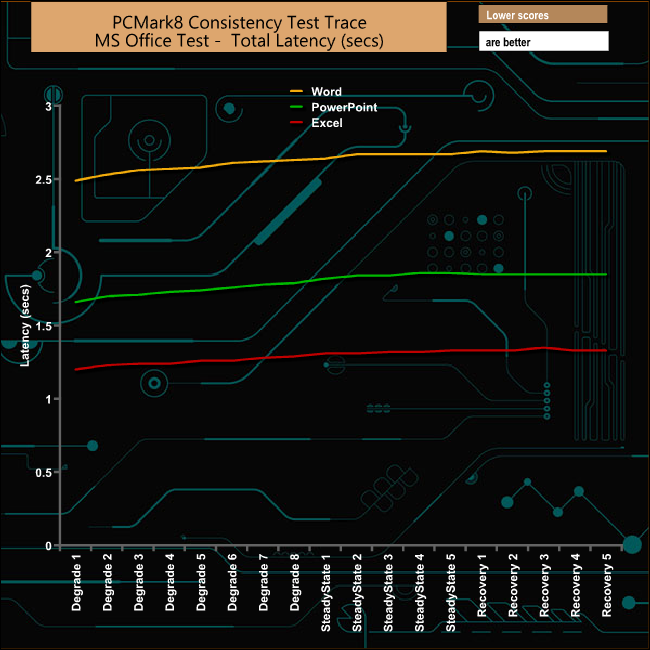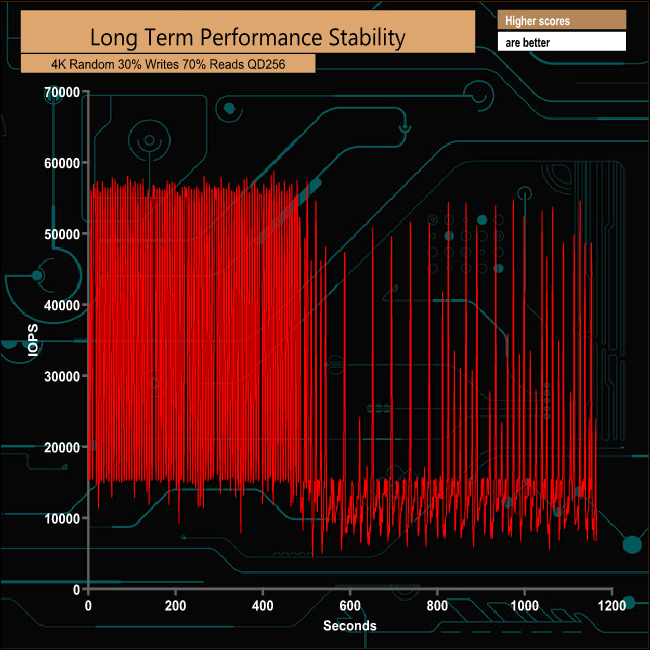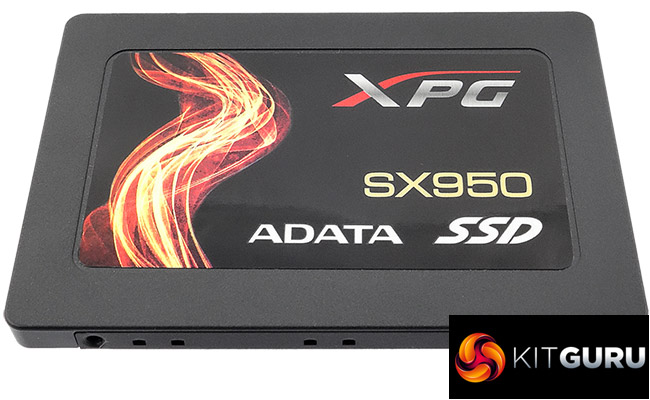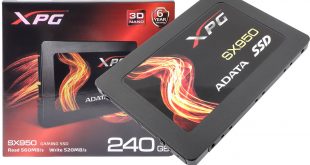
The last drive we looked at from ADATA's XPG range of SSD's aimed at gamers was the SX930. Now it's the turn of the latest member of the 2.5in format family of drives to be put through its paces, the XPG SX950, the first XPG 2.5in drive to use 3D NAND.
ADATA's XPG (Xtreme Performance Gear) range pass the companies most stringent tests for stability and high performance and are aimed at gamers, enthusiasts, and overclockers.
The SX950 range comprises just three capacities, the entry level 240GB drive, 480GB and the flagship 960GB drive. The drives use a combination of 3D MLC NAND and a Silicon Motion 4-channel controller. It also uses intelligent SLC caching and a DRAM cache buffer to boost performance.
ADATA quote sequential performance figures for the 240GB drive as up to 560MB/s for reads and up to 520MB/s for writes. That 560MB/s read speed is the same for all the drives in the range while the 480GB and 960GB drives have slightly faster write speeds at 530MB/s.
The random 4K read speed for the 240GB drive is quoted as up to 80,000 IOPS with writes topping out at 90,000 IOPS. Both the 480GB and 960GB have a maximum read speed of 90,000 IOPS with the 480B drive having the same write speed as the 240GB drive – 90,000 IOPS with the flagship 960GB drive writes dropping to 85,000 IOPS.
The 240GB drive has a rated TBW endurance figure of 200TB, the endurance figures for the 480GB and 960GB drives are quoted as 400TB and 800TB respectively. ADATA back the drive with a generous 6-year warranty.
Physical Specifications:
Usable Capacities: 240GB, 480GB, 960GB
NAND Components: Micron 3D MLC
Interface: Serial ATA (SATA) 6Gb/s (SATA III)
Form Factor: 2.5in
NAND Controller: Silicon Motion SM2258
Dimensions: 100x 69 x 7mm
Drive Weight: 58g
Firmware Version: EXM01B6Q
The ADATA XPG SX950 240GB drive comes in a compact box, the front of which has an image of the drive together with the model number, capacity, the fact it uses 3D NAND and sequential read/write performance figures together with neat flame coloured swoosh type graphic.
The rear of the box has some multilingual marketing details, the read/write performance figures again and a couple of QR codes that access the XPG website.
The drive is bundled with a spacer to use the drive in notebooks with 9mm drive bays, a 3.5in to 2.5in drive bay converter and a warranty booklet.
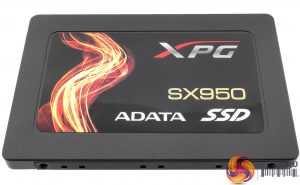
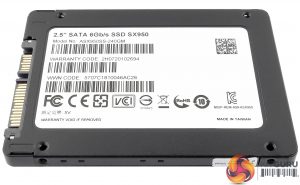
The drive is built on a standard 2.5in, 7mm format with a decent quality metal case with the same swoosh graphic that is on the box front but in a vertical position.
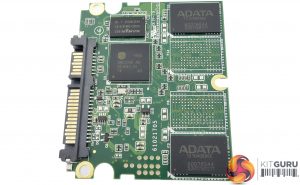
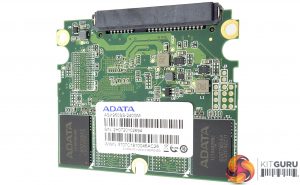
Inside the enclosure sits a compact half size PCB with the Silicon Motion SM2258 controller, two packages of 3D MLC NAND which although are labelled as ADATA are produced by Micron and the 128MB Nanya DDR3L cache IC. The rear of the board houses two more NAND packages.
The Silicon Motion SM2258 is a 4-channel controller using a 32-bit RISC processor supporting 1z nm TLC and 3D MLC/TLC NAND. It supports LDPC ECC technology and has pseudo-SLC caching support.
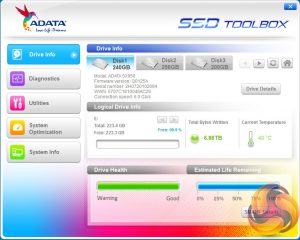
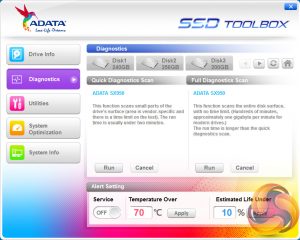
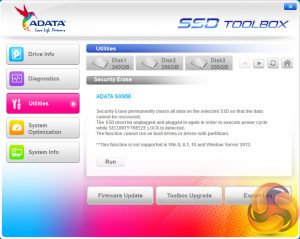
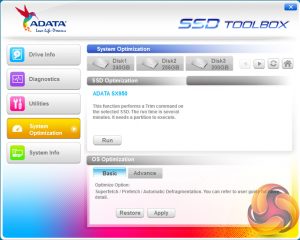
ADATA's management utility for their SSD's is called the SSD Toolbox and it certainly catches the eye as it's about the most colourful looking utility out there. The drive info page displays information about how much capacity is being used and the TBW number.
It also shows the drives temperature, health and how much estimated life the drive has left. There's also a button that links to the S.M.A.R.T. table.
The diagnostics section allows you to perform either quick or full diagnostic scans of the drive and to set the alarms for when the drive gets too hot or gets close to its end of life.
The utilities page is home to the secure erase function and it's also the page where you can update the firmware and the toolbox software and export any logs you have created.
The system optimisation page allows for some OS settings to be changed using two settings Basic or Advanced. Basic options include changing Superfetch, Prefetch, and Automatic Defrag settings.
Advanced changes settings for, Hibernation, NTFS Memory Usage, Large System Cache, Superfetch, Prefetch, and System File in Memory.
For testing, the drives are all wiped and reset to factory settings by HDDerase V4. We try to use free or easily available programs and some real world testing so you can compare our findings against your own system.
This is a good way to measure potential upgrade benefits.
Main system:
Intel Core i7 4790K with 16GB of DDR3-2133 RAM, Sapphire R9 390 Nitro and an ASRock Extreme 6 motherboard.
Other drives:
ADATA SX930 240GB
Crucial MX100 256GB
Intel 335 240GB
Intel SSD730 240GB
Kingston HyperX Savage 240GB
Micron M600 256GB
OCZ Agility 4 256GB
OCZ ARC 100 240GB
OCZ Trion 100 240GB
OCZ Trion 150 240GB
OCZ Trion 150 480GB
OCZ Vector 150 256GB
OCZ Vector 240GB
OCZ Vertex 3 240GB MAX IOPS
OCZ Vertex 450 256GB
OCZ Vertex 460 240GB
Patriot Wildfire 240GB
Plextor M5 Pro 256GB
Plextor M6V 256GB
PNY CS2211 240GB
PNY XLR8 240GB
Samsung 840 EVO 250GB
Samsung 840 Pro 256GB
SanDisk Extreme II 240GB
SanDisk X400 256GB
Seagate 600 Pro 200GB
Software:
Atto Disk Benchmark.
CrystalMark 3.0.3.
AS SSD.
IOMeter
All our results were achieved by running each test five times with every configuration this ensures that any glitches are removed from the results. Trim is confirmed as running by typing fsutil behavior query disabledeletenotify into the command line. A response of disabledeletenotify =0 confirms TRIM is active.
Crystalmark is a useful benchmark to measure theoretical performance levels of hard drives and SSD’s. We are using V3.0.3.
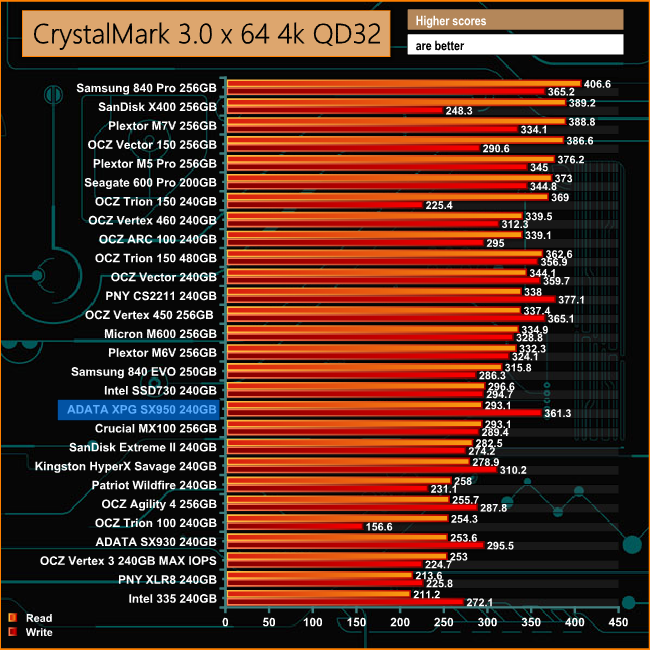
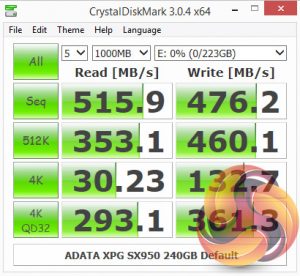
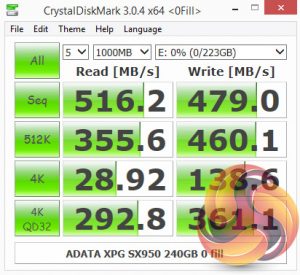
The SX950 handles writing small files at deepish queue depths very well, much better than its read performance. It's the same story at a queue depth of 1 as well. Looking at the two benchmark results screens it appears the Silicon Motion SM2258 controller doesn't care what type of data it's being asked to work with.
The ATTO Disk Benchmark performance measurement tool is compatible with Microsoft Windows. Measure your storage systems performance with various transfer sizes and test lengths for reads and writes. Several options are available to customize your performance measurement including queue depth, overlapped I/O and even a comparison mode with the option to run continuously.
Use ATTO Disk Benchmark to test any manufacturers RAID controllers, storage controllers, host adapters, hard drives and SSD drives and notice that ATTO products will consistently provide the highest level of performance to your storage.
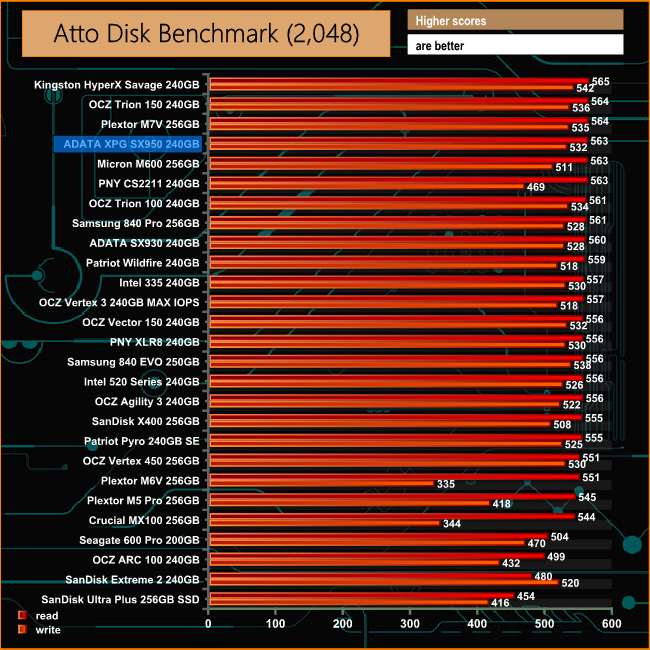
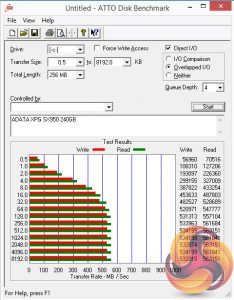
ADATA quote outright performance figures for the 240GB SX950 as up to 560MB/s for reads and 520MB/s for writes, figures we could confirm were bang on the money as when the drive was tested with the ATTO benchmark it produced a read score of 563MB/s. Writes were even a little better than the official figure at 532MB/s.
AS SSD is a great free tool designed just for benching Solid State Drives. It performs an array of sequential read and write tests, as well as random read and write tests with sequential access times over a portion of the drive. AS SSD includes a sub suite of benchmarks with various file pattern algorithms but this is difficult in trying to judge accurate performance figures.
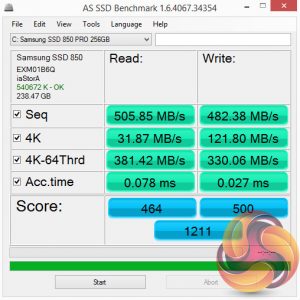
The SX950 produced excellent read/write scores in the more stringent AS-SSD benchmark, with a write score of 500 being the fastest score we have seen to date for a 2.5in consumer SSD in the 240GB/256GB segment. The read score of 464 is very impressive as well.
IOMeter is another open source synthetic benchmarking tool which is able to simulate the various loads placed on hard drive and solid state drive technology.
We test with both random read and write 4k tests, as shown above. There are many ways to measure the IOPS performance of a Solid State Drive, so our results will sometimes differ from manufacturer’s quoted ratings. We do test all drives in exactly the same way, so the results are directly comparable.
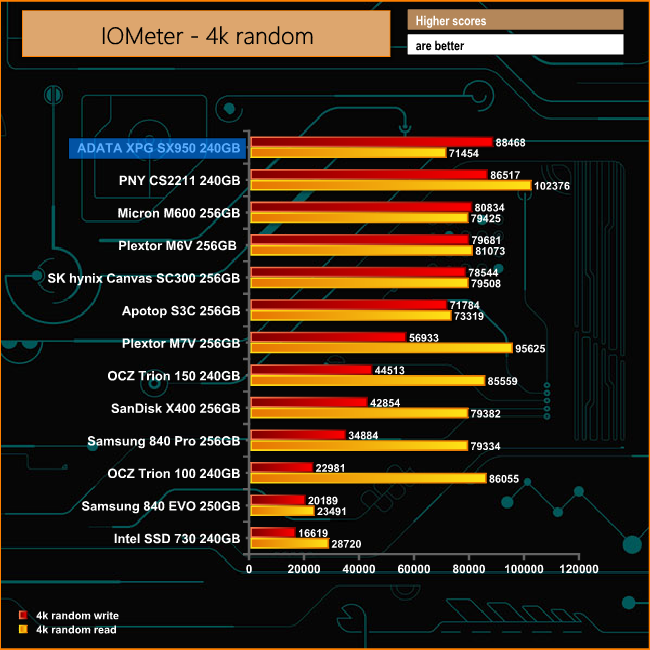
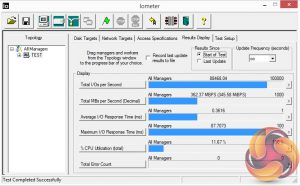
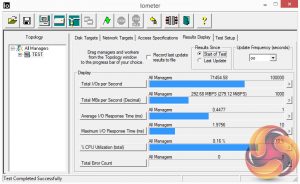
The quoted 4K random read/write figures for the drive are up to 80,000 IOPS for reads and 90,000 for writes and although the review drive didn't quite make those figures when tested, with reads coming in at 71,454 IOPS.
However, the write score of 88,468 IOPS is the fastest we have seen for a consumer 2.5in drive in this capacity segment.
Futuremark’s PCMark 8 is a very good all round system benchmark but it’s Storage Consistency Test takes it to whole new level when testing SSD drives. It runs through four phases; Preconditioning, Degradation, Steady State, Recovery and finally Clean Up. During the Degradation, Steady State and Recovery phases it runs performance tests using the 10 software programs that form the backbone of PCMark 8; Adobe After Effects, Illustrator, InDesign, Photoshop Heavy and Photoshop Light, Microsoft Excel, PowerPoint, Word, Battlefield 3 and World of Warcraft. With some 18 phases of testing, this test can take many hours to run.
Preconditioning
The drive is written sequentially through up to the reported capacity with random data, write size of 256 × 512 = 131,072 bytes. This is done twice.
Degradation
Run writes of random size between 8 × 512 and 2048 × 512 bytes on random offsets for 10 minutes. It then runs a performance test. These two actions are then repeated 8 times and on each pass the duration of random writes is increased by 5 minutes.
Steady State
Run writes of random size between 8 × 512 and 2048 × 512 bytes on random offsets for final duration achieved in degradation phase. A performance test is then run. These actions are then re-run five times.
Recovery
The drive is idled for 5 minutes. Then a performance test is run. These actions are then repeated five times.
Clean Up
The drive is written through sequentially up to the reported capacity with zero data, write size of 256 × 512 = 131,072 bytes.
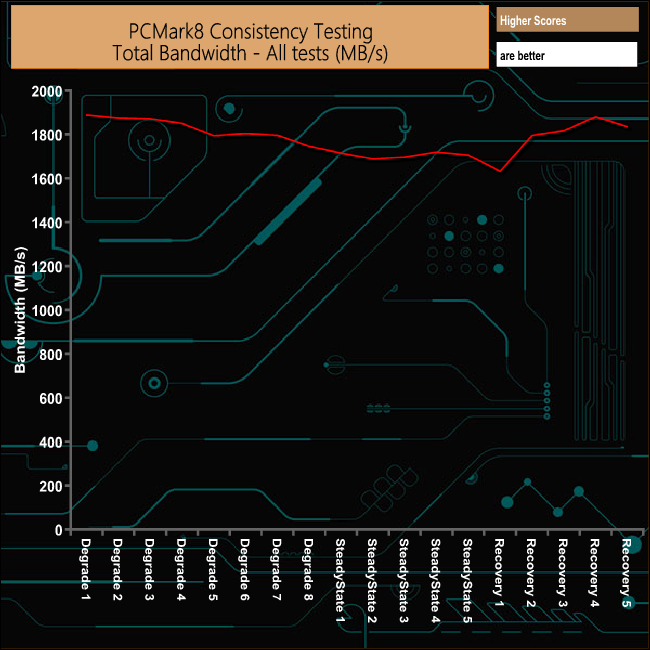
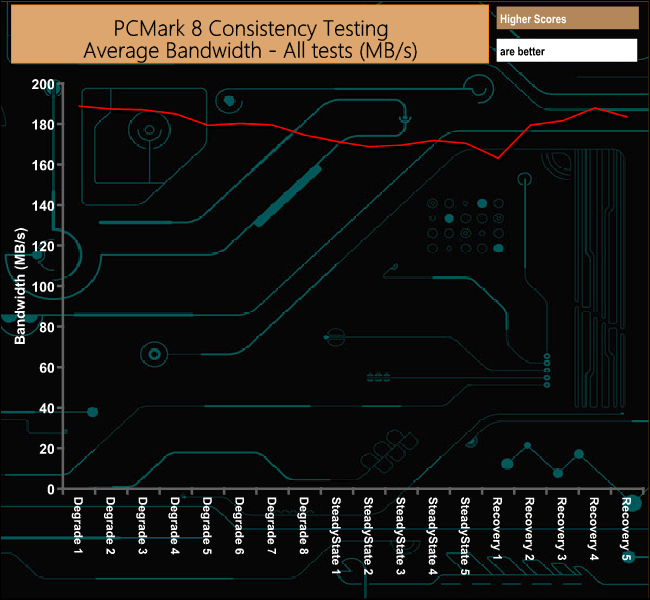
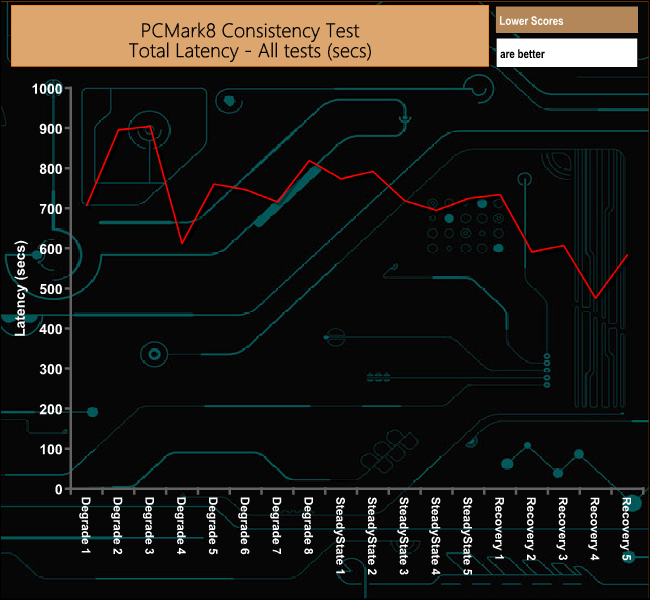
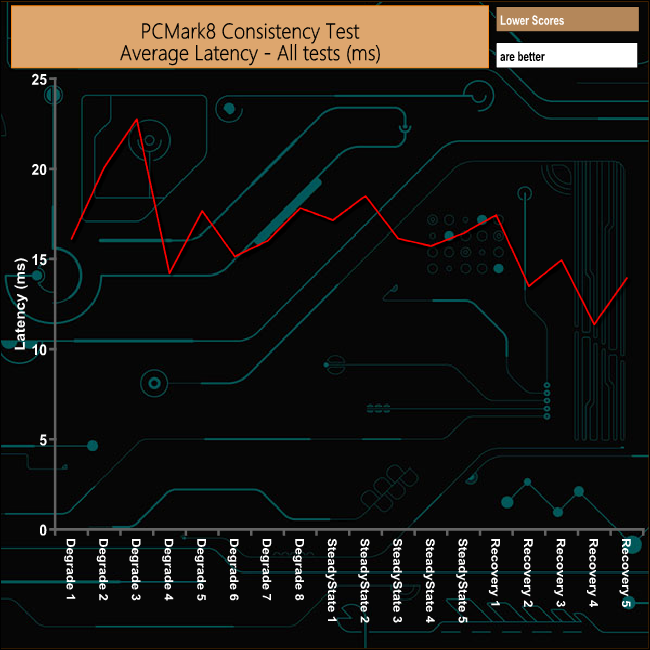
Overall, ADATA's SX950 handled the stress of the PCMark 8 Consistency test pretty well. Its performance dropping in a fairly controlled way during the degradation and steady state phases and it recovered reasonably well too.
PCMark 8’s Consistency test provides a huge amount of performance data, so here we’ve looked a little closer at how the ADATA XPG SX950 240GB drive performs in each of the benchmarks test suites.
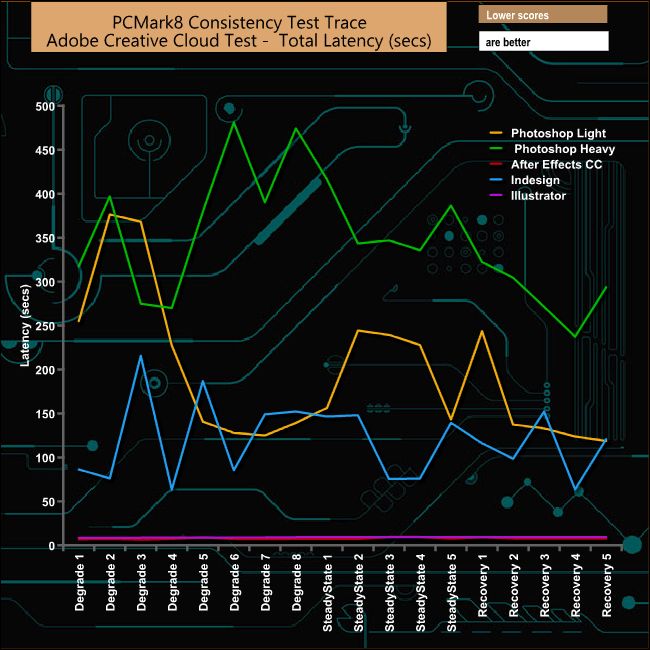
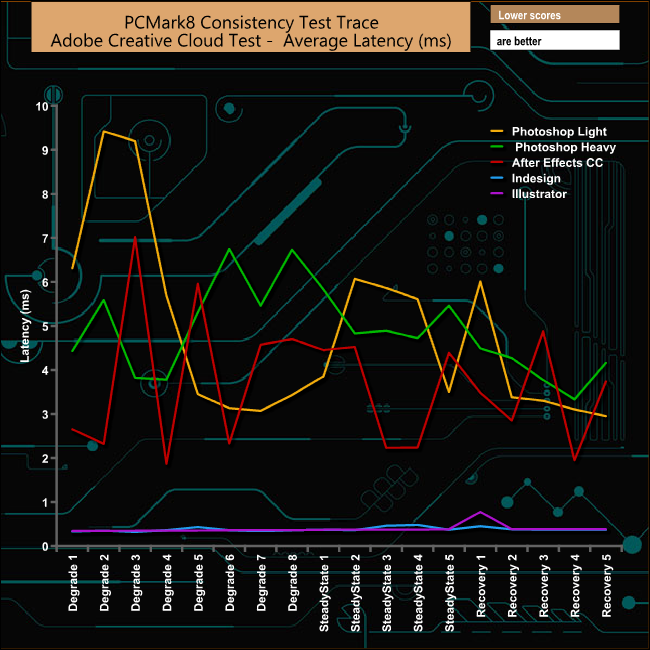
Getting into the detail of the Consistency test, the drive did struggle with the Photoshop Heavy tests but that's not that unusual as its a very stressful test that trips up most drives
Microsoft Office
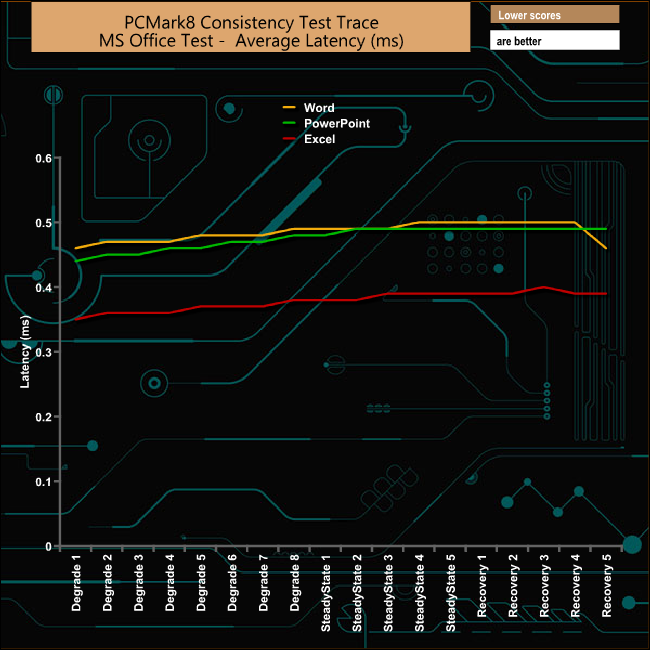
The drive had no problems dealing with the MS Office traces of PCMark8's Consistency test showing a consistent level of performance throughout the tests.
Casual Gaming
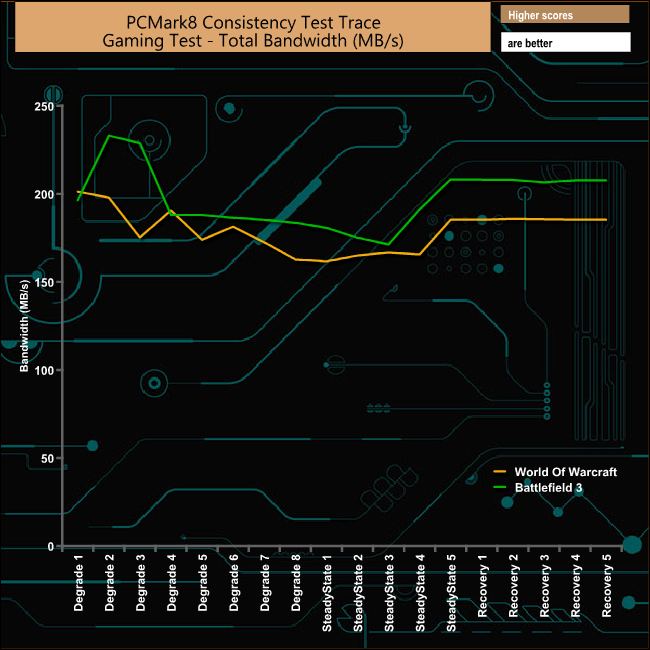
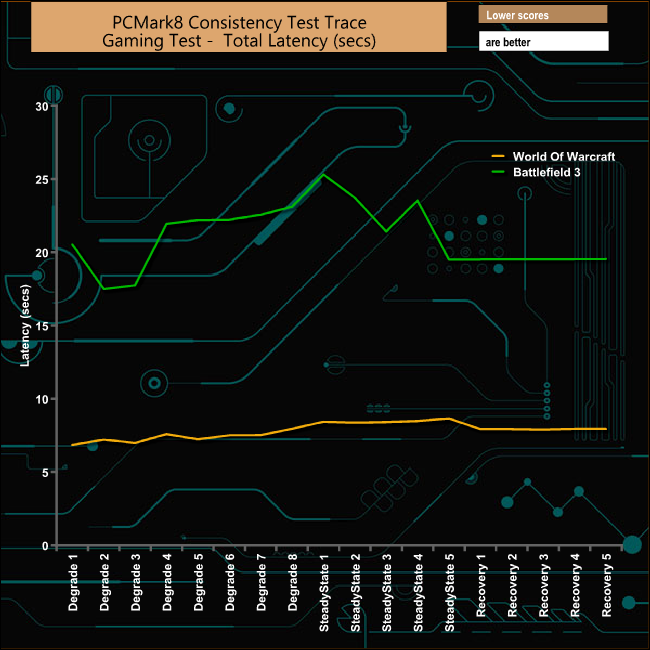
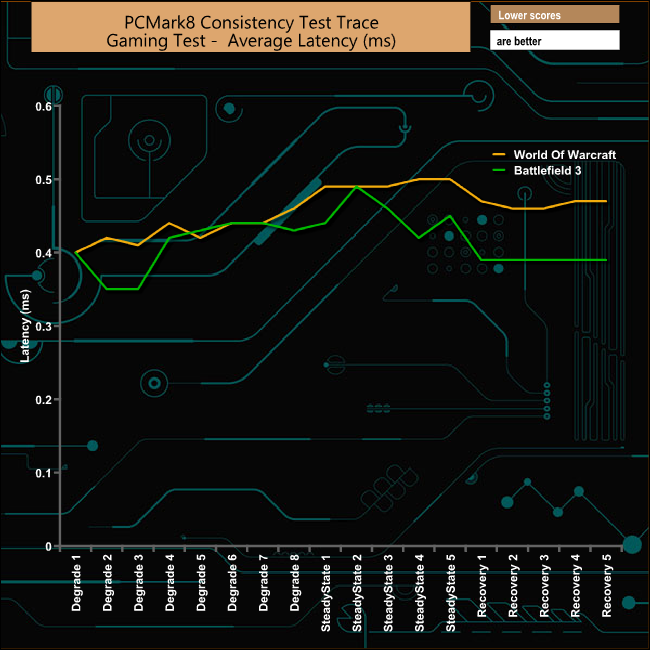
In the casual gaming tests of the benchmark, the drive's performance did tack a knock during the degradation and steady state cycles particularly when tested with the Battlefield 3 traces but it recovered well from the ordeal.
Just like the Consistency test, PCMark 8’s standard Storage test also saves a huge amount of performance data. The default test runs through the test suite of 10 applications three times. Here we show the total bandwidth performance for each of the individual test suites for the third and final benchmark run.
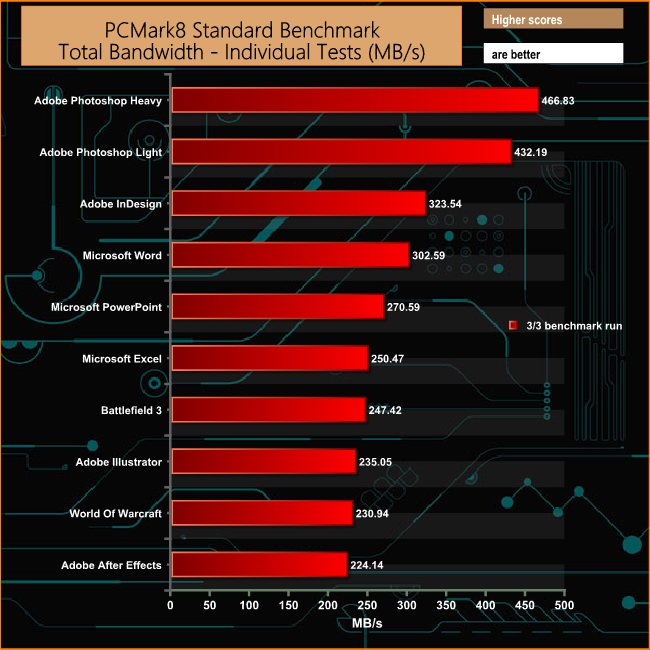
The Adobe Photoshop Heavy test is the most taxing for drive's but it didn't seem to phase the SX950 in the slightest with a bandwidth of 466.83MB/s in the third and final test run. The average bandwidth for the three Microsoft tests in the final run was a very respectable 274.55MB/s
For the long term performance stability test, we set the drive up to run a 20-minute 4K random test with a 30% write, 70% read split, at a Queue Depth of 256 over the entire disk. The SX950 240GB drive averaged 23,813 IOPS for the test with a performance stability of 41.9%.
To test real life performance of a drive we use a mix of folder/file types and by using the FastCopy utility (which gives a time as well as MB/s result) we record the performance of the drive reading from & writing to a 256GB Samsung SSD850 PRO.
60GB Steam folder – 29,521 files.
50GB File folder – 28,523 files.
12GB Movie folder – 24 files (mix of Blu-ray and 4K files).
10GB Photo folder – 621 files (mix of .png, raw and .jpeg images).
10GB Audio folder – 1,483 files (mix of mp3 and .flac files).
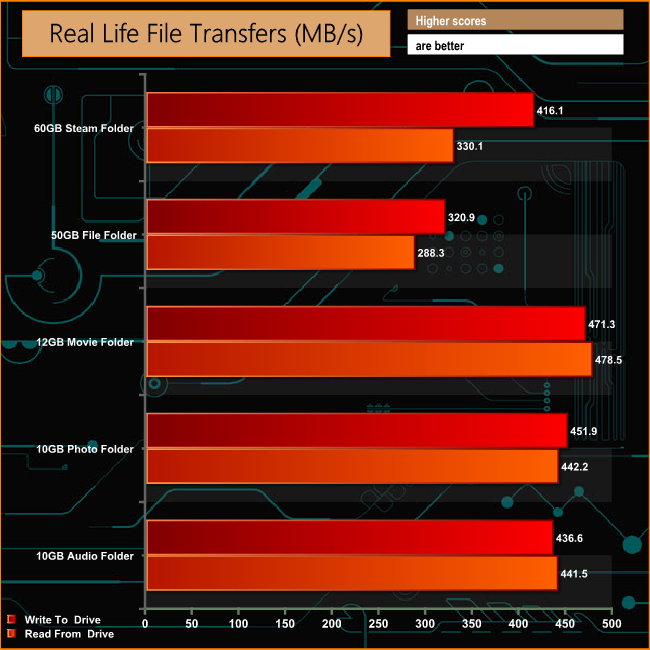
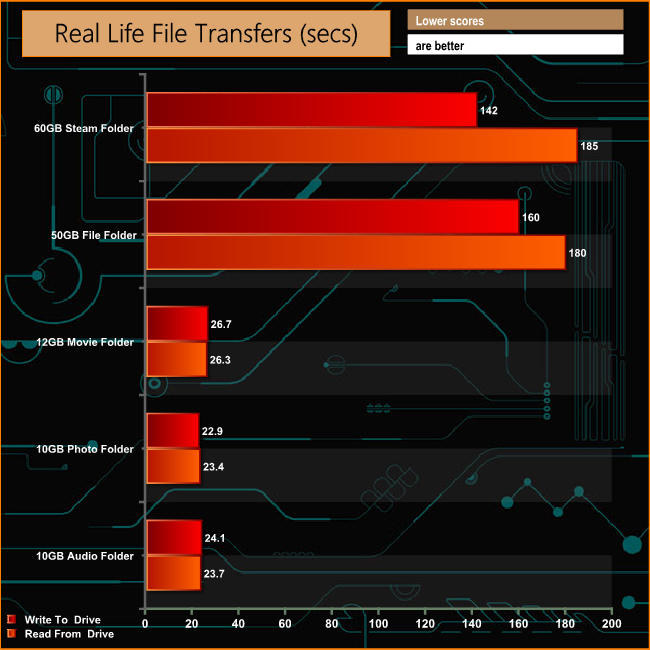
The SX950 dealt with the real life file transfers generally very well although the performance did drop back in both phases when dealing with the 50GB file folder and when reading back the contents of the 60GB Steam folder.
Although the SX950 is ADATA's first XPG branded 2.5in drive to use 3D NAND, the company have embraced the latest NAND technology fully and it can be found in both MLC and TLC guises throughout its ranges of 2.5in, M.2 and external SSDs.
The official headline Sequential performance figures for the 240GB version of the XPG SX950 are up to 560MB/s for reads and 520MB/s for writes which we were able to confirm with the ATTO benchmark. When tested our review drive produced a read performance of 563MB/s and writes which at 532MB/s, were a wee bit faster than the official figure.
We couldn't quite match the official figures when it came to 4K random read/write IOS performance. Under our IOMeter test configuration, the drive produced 71,454 IOPS, which was a bit below the official 80,000 IOPS. The write performance, however, was a lot closer to the official 90,000 IOPS at 88,468 IOPS, which is incidentally the fastest write IOPS performance we have seen to date for a consumer drive in the 240/256GB bracket.
The SSD Toolbox is a useful utility that lets you perform most of the maintenance task you might need for an SSD as well as informing about the drives well-being and how the capacity is being used.
ADATA back the drive with a useful 6-year warranty.
We found the 250GB ADATA XPG SX950 for £124.44 (inc VAT) on Kikatek.com HERE.
Discuss the review on our Facebook page, over HERE.
Pros
- Fast overall performance.
- 4K write performance.
- That 6-year warranty.
- SSD Toolbox software.
Cons
- 4K read performance.
Kitguru says: ADATA's XPG SX950 is a fast performing SSD using 3D MLC NAND and it comes with a fantastic 6 year warranty.
Be sure to check out our sponsors store EKWB here
 KitGuru KitGuru.net – Tech News | Hardware News | Hardware Reviews | IOS | Mobile | Gaming | Graphics Cards
KitGuru KitGuru.net – Tech News | Hardware News | Hardware Reviews | IOS | Mobile | Gaming | Graphics Cards


